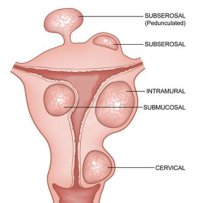What are Fibroids?
Fibroid tumors are benign (non-cancerous) growths that appear on the muscular wall of the uterus. They are the most common tumors of the body. Fibroids also go by names like leiomyoma, leiomyomata, or myoma. They range in size from microscopic to masses that fill the entire abdominal cavity, and there is often more than one at a time. In some cases, they can be as large as a full-term pregnancy. This condition can affect women of all ages but is most common in women ages 40 to 50.
Fibroids consist of dense, fibrous tissue (hence the name ‘fibroid’) and are usually supplied blood by the uterine artery. Fibroid symptoms vary depending on their number and location in the uterus.

There are 3 different locations: intramural, submucosal, and subserosal uterine fibroids.
What is a Intramural Fibroid?
Intramural Fibroid is located in the wall of the uterus and are the most common type. They cause the uterus to become enlarged, and can cause pelvic pain, heavy menstrual bleeding, back pain, and pressure. All fibroids originate in the wall, and then often ‘migrate’ to other locations.
What is a Submucosal Fibroid?
Submucosal Fibroid is located inside the lining of the uterus and protrude inward. These cause heavy bleeding and prolonged periods and anemia.
What is a Subserosal Fibroids?
Subserosal Fibroid is located outside of the lining of the uterus and protrude outward. They have less of an effect on your period but may cause back pain or bladder pressure. Subserosal and submucosal fibroid can also grow on a stalk attached to the uterus, in which case it is called ‘pedunculated.’ The stalk may become twisted and can cause severe pelvic pain.
What are the symptoms?
While not cancerous, they can cause problems. Depending on size, location and amount, common fibroid symptoms include:
- Pelvic pain and pressure
- Excessive bleeding, prolonged periods and passage of clots, anemia
- Abdominal swelling
- Bladder pressure, leading to frequent urination
- Pressure on the bowel, leading to constipation and bloating
- Pregnancy complications
Though very common, only 10 to 20 percent need treatment, according to the University of Miami Health System. Even if you experience light symptoms, you may still need treatment and should consult a professional.
Why do I have them?
No one knows. Fibroids affect 40% of women over 35 years in America and have a higher incidence among African Americans. There is a link between uterine fibroid tumors and estrogen production. They can grow very large during pregnancy when estrogen levels are high. They sometimes improve during menopause, when estrogen levels decrease.
How do I find out if I have fibroids?
Women usually will undergo an ultrasound to determine if fibroids are present. Magnetic Resonance Imaging (MRI) is also used to determine if it can be treated with embolization and provide information about any underlying disease.
Treatment
There are many treatments available. If your fibroid surgeon recommends a hysterectomy, you may want to obtain a second opinion and be aware of all your options. Most women with symptomatic fibroids are candidates for Uterine Fibroid Emblolization but should consult with their doctor to determine if it is the right choice for them.
Uterine Artery Embolization is Non-Surgical
Uterine artery embolization (UAE), also called uterine fibroid embolization (UFE), is an endovascular procedure, meaning it is done through the arterial system. It is non-surgical and minimally invasive. It does not require general anesthesia- the groin is numbed and the patient is sedated, but still conscious enough to respond to questions.
The Procedure
The physician first makes a small nick in the skin on the groin, above the femoral artery and inserts a catheter. Under x-ray guidance, the doctor identifies the uterine artery on both sides of the uterus. These arteries supply blood for the tumors in most patients. The doctor then injects tiny particles, about the size of a grain of sand, into the uterine arteries to block the blood supply to the uterus, causing the tumor(s)to shrink.
Recovery time after embolization is usually an overnight stay in the hospital, mostly to monitor pain with pain medications. Most women return to light activities and work within one week. After embolization, bleeding stops immediately in most patients, and the tumors shrink gradually to about 50% within 6 months.
Surgery Options
Surgical treatment including hysterectomy, which removes the entire uterus. Myomectomy, which removes the tumor but leaves the uterus. Both are major surgeries that require 4 days in the hospital and a 6-week recovery period. Myomectomy can preserve fertility, but carries the additional risk of recurrence, since most women have multiple fibroids and it is impossible to cut them all out. Moreover, small fibroids will often grow into large ones with time.
Have questions? We can help.
If you are showing signs of fibroid symptoms and think you have fibroids, schedule an appointment for a professional diagnosis. One of our fibroid surgeons will talk to you about your symptoms and perform a pelvic exam. We may order further testing including an imaging procedure such as an ultrasound.
If diagnosed, uterine fibroid embolization may be your best fibroid treatment option; it has a 95% success rate with patients. We offer free consultations in-office or over the phone. For more information on fibroids, feel free to contact us at 1 (866) 479-1523 or request a free consultation online.
Embolization Helped Sonia Get Her Confidence Back
As a small woman Sonia couldn’t understand why she could never get rid of her “pooch.” She soon learned it was due to fibroids. After having Embolization, Sonia was able to get her confidence back and feel great in a two piece bathing suit!


